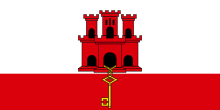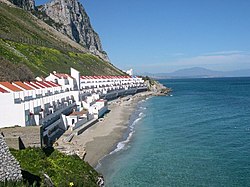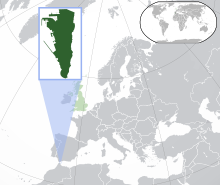Our website is made possible by displaying online advertisements to our visitors.
Please consider supporting us by disabling your ad blocker.
Portal:Gibraltar
The Gibraltar Portal Gibraltar (/dʒɪˈbrɔːltər/ ⓘ jib-RAWL-tər, Spanish: [xiβɾalˈtaɾ]) is a British Overseas Territory and city located at the southern tip of the Iberian Peninsula, on the Bay of Gibraltar, near the exit of the Mediterranean Sea into the Atlantic Ocean (Strait of Gibraltar). It has an area of 6.8 km2 (2.6 sq mi) and is bordered to the north by Spain (Campo de Gibraltar). The landscape is dominated by the Rock of Gibraltar, at the foot of which is a densely populated town area, home to some 34,003 people, primarily Gibraltarians. Gibraltar was founded as a permanent watchtower by the Almohads in 1160. It switched control between the Nasrids, Castilians and Marinids in the Late Middle Ages, acquiring larger strategic clout upon the destruction of nearby Algeciras c. 1375. It became again part of the Crown of Castile in 1462. In 1704, Anglo-Dutch forces captured Gibraltar from Spain during the War of the Spanish Succession, and it was ceded to Great Britain in perpetuity under the Treaty of Utrecht in 1713. It became an important base for the Royal Navy, particularly during the Napoleonic Wars and World War II, as it controlled the narrow entrance and exit to the Mediterranean Sea, the Strait of Gibraltar, with half the world's seaborne trade passing through it. The sovereignty of Gibraltar is a point of contention in Anglo-Spanish relations as Spain asserts a claim to the territory. Gibraltarians overwhelmingly rejected proposals for Spanish sovereignty in a 1967 referendum, and for shared sovereignty in a 2002 referendum. Nevertheless, Gibraltar maintains close economic and cultural links with Spain, with many Gibraltarians speaking Spanish as well as a local dialect known as Llanito. (Full article...) Selected article - The tunnels of Gibraltar were constructed over the course of nearly 200 years, principally by the British Army. Within a land area of only 2.6 square miles (6.7 km2), Gibraltar has around 34 miles (55 km) of tunnels, nearly twice the length of its entire road network. The first tunnels, excavated in the late 18th century, served as communication passages between artillery positions and housed guns within embrasures cut into the North Face of the Rock. More tunnels were constructed in the 19th century to allow easier access to remote areas of Gibraltar and accommodate stores and reservoirs to deliver the water supply of Gibraltar. The 20th century saw by far the greatest extent of tunnelling when the Rock was turned into a huge underground fortress capable of accommodating 16,000 men along with all the supplies, ammunition and equipment needed to withstand a prolonged siege. The tunnelling finally ceased in 1968 when the British Army's last specialist tunnelling unit was disbanded. Since then, the tunnels have progressively been turned over to the civilian Government of Gibraltar, although a number are still owned by the Ministry of Defence and some have been sealed off entirely as they are now too dangerous to enter. (Full article...) Selected picture Photo credit: Christina Cortes
View of Sandy Bay on the Eastern Mediterranean coast of Gibraltar, showing the old water catchments' slope restored and looking North towards Spain's Costa del Sol.
Selected quote
SubcategoriesSelected biography -General Sir William Green, 1st Baronet FRS (4 April 1725 – 10 January 1811) was a British Army officer, of Marass, Kent. He served as chief engineer at the Great Siege of Gibraltar. After receiving a private education in Aberdeen, Scotland and a military education at the Royal Military Academy in Woolwich, England, he was appointed as a practitioner engineer in 1743. Green served on the European continent until 1752, after which he was in Canada. There, he continued to advance through both the ordinary military and engineering ranks. (Full article...)
Did you know...
General imagesThe following are images from various Gibraltar-related articles on Wikipedia.
Topics Buildings: The Convent | Dudley Ward Tunnel | Garrison Library | Moorish Castle Communications: .gi | Gibraltar Broadcasting Corporation | Gibraltar Chronicle | Telecom dispute Culture: Cuisine | Gibraltarian people |Gibraltarian status | Languages | Llanito | Music Flora and fauna: Gibraltar Barbary Macaques | Gibraltar candytuft | GONHS | List of birds of Gibraltar | Mammals | List of reptiles and amphibians in Gibraltar | Rock of Gibraltar | The Alameda Gardens History: Battle of Gibraltar | Death on the Rock | Explosion of the RFA Bedenham | George Augustus Eliott, 1st Baron Heathfield | George Rooke | Gibraltar real | Great Siege of Gibraltar | History of the Maltese | History of Nationality | Kingdom of Gibraltar | Military history of Gibraltar during World War II | Moorish Castle | Aurora incident | Pillars of Hercules | Treaty of Utrecht Military: British Forces Gibraltar | Royal Gibraltar Regiment | RAF Gibraltar | HMS Gibraltar | Gibraltar Services Police | Royal Gibraltar Police Symbols: Coat of arms | Flag | Gibraltar Anthem | Other Flags Politics and economy: Chief Minister | Constitution Order (1969, 2006) | Disputed status | Elections | Gibraltar Constitution Order 2006 | Parliament | Gibraltarian pound | Governor | Political parties Religion: Cathedral of St. Mary the Crowned | Cathedral of the Holy Trinity | Great Synagogue | Hinduism | History of the Jews in Gibraltar | Ibrahim-al-Ibrahim Mosque | Methodism | Roman Catholicism | St Andrew's Church Related portalsThings you can doSee alsoAssociated WikimediaThe following Wikimedia Foundation sister projects provide more on this subject:
Discover Wikipedia using portals | ||||||||
Previous Page Next Page


































































